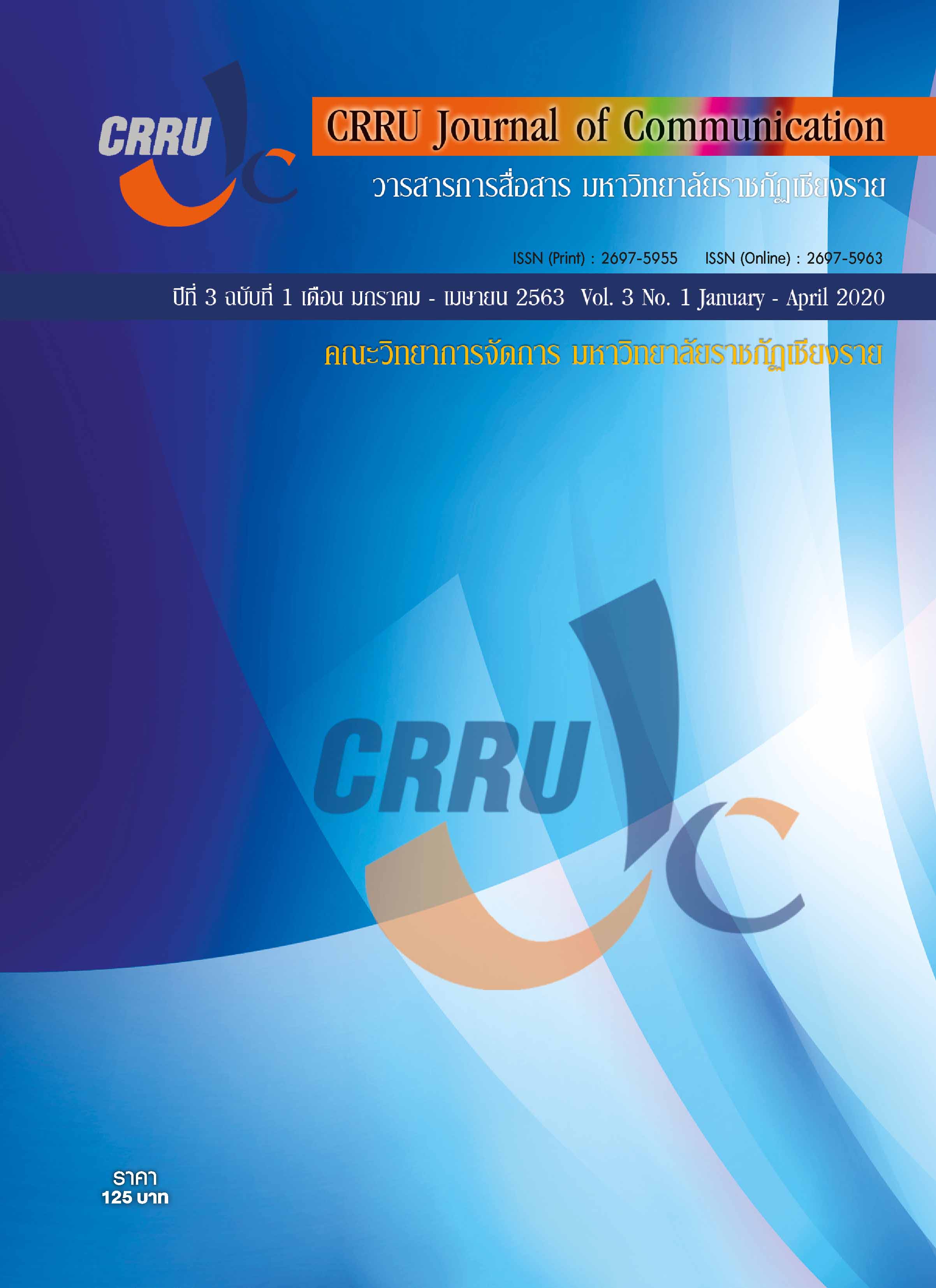Parody of Political Satire on Facebook Page
Main Article Content
Abstract
This quantitative research Parody of Political Satire on Facebook Page is to study how politics is represented in different satirical ways, based on the contents of political Facebook pages by gathering data posted on the Cat Egg X page that contains various satirical contents of political news. This page is divided into two main areas of analysis depending on certain contents that reflect particular political situations, and tactics or different degrees of parody. The duration of the study was 6 months from January 1st, 2019 – June 30th, 2019, a total of 166 posts.
The results are analyzed using interpretive and comparative methods on each present content in order to understand the context of society along with the meaning of symbols, posted and used to describe related events. Accordingly, the first part of the analysis, which is a reflection of political events finds that there are 7 types of common content which are the behavior of politicians, people who are related to politics, political parties, elections, government policies, important current events and institutions which are related to politics. Another part is the strategy of parody and satire. It finds that there are 4 different types of parody which are trivialization (joke modification), comparison and exaggeration, and inversion (role switches). All content reflects distrust toward the government in the public view. This is because the period of the official election was held after the coup in 2014, and the nation has been ruled by the National Council for Peace and Order, known as the military junta for 5 years. The election demands the qualifications of candidates. Political activists and people who criticize their views holding on the principles of democracy on social media, which is considered a public sphere to freely express their opinions based on freedom and independence. Instead, these people are controlled and arrested by invisible power or laws resulting in changing the expressions of political opinions to avoid conflict by using “Political Caricatures” which are adapted each content to be jokes, and by changing the content to be easily accessible in order to reduce tension in content without annotations. This allows readers to imagine and perceive in their own ways which is the beginning step of fighting through diverse thoughts in a political way by the use of advanced technological innovation as an incentive in the long run.
Article Details
References
กาญจนา แก้วเทพ. (2547). การวิเคราะห์สื่อ แนวคิด และเทคนิค. ครั้งที่ 4. กรุงเทพฯ: แบรนด์เอจ จำกัด.
ฉัตรบงกช ศรีวัฒนสาร. (2557). ภาพล้อและการ์ตูนการเมืองในสังคมไทย พ.ศ. 2465-2475. วารสารศิลปกรรมศาสตร์วิชาการ วิจัย และงานสร้างสรรค์, 1(1), 62-79.
เฉลิมรัฐ พิกุล. (2556). การศึกษาเพื่อการสร้างสรรค์: การ์ตูนล้อเลียน ภาพสะท้อนการเมืองไทย กรณีศึกษา : จากการ์ตูนล้อการเมืองช่วงปี (พ.ศ. 2552- 2554). ปริญญานิพนธ์ศิลปะกรรมศาสตรมหาบัณฑิต. มหาวิทยาลัยศรีนครินทรวิโรฒ, คณะศิลปกรรมศาสตร์, สาขาวิชาทัศนศิลป์: ศิลปะสมัยใหม่.
ญาดา ชาญบัญชี. (2551). กลวิธีการใช้ภาษาในงานเขียนอารมณ์ขันของ เกตุเสพย์สวัสดิ์ ปาลกะวงศ์ ณ อยุธยา.ปริญญานิพนธ์การศึกษามหาบัณฑิต. มหาวิทยาลัยศรีนครินทรวิโรฒ, คณะมนุษยศาสตร์, สาขาวิชาภาษาศาสตร์การศึกษา.
ไทยรัฐออนไลน์. (2562). การผจญภัยใหม่ของ ชัย ราชวัตร ผมจะกลับมาเมื่อชาติต้องการ!!. สืบค้น 7 พฤศจิกายน 2561, จาก https://www.thairath.co.th/news/society/1570445
ธวัลกร บุญศรี. (2556). สื่อที่ส่งผลต่อการมีส่วนร่วมทางการเมือง: กรณีศึกษา การเข้าร่วมชุมนุมทางการเมือง เวทีราชดำเนิน ในปี 2556. การค้นคว้าอิสระนิเทศศาสตรมหาบัณฑิต. มหาวิทยาลัยกรุงเทพ, คณะนิเทศศาสตร์, สาขาวิชาการสื่อสารเชิงกลยุทธ์.
ธีรยุทธ์ เกณฑ์บุตร. (2554). การใช้ภาษาแสดงอารมณ์ขันในการ์ตูนล้อการเมือง. วิทยานิพนธ์ศิลปศาสตรมหาบัณฑิต. มหาวิทยาลัยทักษิณ, คณะมนุษยศาสตร์, สาขาวิชาภาษาไทย.
พัฒนะชัย พัชรเดช และ อุมาภรณ์ สังขมาน. (2559). กลวิธีทางวัจนปฏิบัติศาสตร์ในเดี่ยวไมโครโฟนของอุดม แต้พานิช. วารสารวจนะ. 4(2), 20-39.
พิรงรอง รามสูตร, พิมลพรรณ ไชยนันท์ และ อิทธิพล วรานุศุภากุล. (2562). การสื่อสารและพลวัตทางการเมือง. มหาวิทยาลัยสุโขทัยธรรมาธิราช บัณฑิตศึกษา สาขาวิชารัฐศาสตร์.
ไพศาล ธีรพงศ์วิษณุพร. (2561). 140 ปี “การ์ตูน” เมืองไทย(ประวัติและตำนาน พ.ศ.2417-1557). กรุงเทพฯ: สำนักพิมพ์ศรีปัญญา.
เพจไข่แมว. (n.d.). ไข่แมวX [Facebook]. Retrieved March 8, 2020, from https://web.facebook.com /cartooneggcatx/
มูลนิธิ ประยูร จรรยาวงษ์. (2559). นายศุกเล็ก. สืบค้น 7 พฤศจิกายน 2561, จาก http://sooklek.com/
ฤทัย รอดภัย. (2541). การวิเคราะห์เนื้อหาการ์ตูนล้อการเมือง ในหนังสือพิมพ์รายวัน ฉบับภาษาไทย 3 ฉบับ ในช่วงการบริหารงานของพลเอกชวลิต ยงใจยุทธ นายกรัฐมนตรีคนที่ 22 ของไทย. วิทยานิพนธ์วารสารศาสตรมหาบัณฑิต. มหาวิทยาลัยธรรมศาสตร์, คณะวารสารศาสตร์และสื่อสารมวลชน, สาขาวิชาสื่อสารมวลชน.
ศศิญากร เถาหมอ. (2556). การศึกษาเนื้อหาการ์ตูนล้อการเมืองของหนังสือพิมพ์โพสต์ทูเดย์และหนังสือพิมพ์ในยุครัฐบาลยิ่งลักษณ์ ชินวัตร ปีพ.ศ. 2554-2555. ปทุมธานี: คณะวารสารศาสตร์และสื่อสารมวลชน มหาวิทยาลัยธรรมศาสตร์.
สื่อสารของมนุษยชาติและผลกระทบต่อจริยธรรมสื่อ. (2545). การสื่อข่าว: หลักการและเทคนิค. สืบค้น 7 พฤศจิกายน 2561 จาก http://utcc2.utcc.ac.th/localuser/amsar/PDF/New%20Media.pdf.
สุนทรี ดวงทิพย์. (2560). สักทองการวิเคราะห์เนื้อหาในคอลัมน์การ์ตูน ผู้ใหญ่มากับทุ่งหมาเมิน จากหนังสือพิมพ์ไทยรัฐ. วารสารมนุษยศาสตร์และสังคมศาสตร์. 23(3), 83-93.
สุรพงษ์ โสธนะเสถียร. (2557). ทฤษฎีการสื่อสาร. กรุงเทพฯ: คณะวารสารศาสตร์และสื่อมวลชน มหาวิทยาลัยธรรมศาสตร์.
สุวรรณา งามเหลือ. (2559). การศึกษาวิเคราะห์ภาพล้อสังคมไทยในสื่อสังคมออนไลน์. วารสารนานาชาติมหาวิทยาลัยขอนแก่น สาขามนุษยศาสตร์และสังคมศาสตร์. 6(1), 50-79.
ศิริพร ภักดีผาสุก. (2559). อารมณ์ขันในการ์ตูนการเมืองไทย. วารสารภาษาและวรรณคดีไทย. 23(1), 86-143.
อลงกต ตันเทิดทิตย์. (2559). การ์ตูนข่าว 4.0: ภาพสะท้อนสังคมในโลกยุคดิจิทัล. การค้นคว้าอิสระนิเทศศาสตรมหาบัณฑิต. มหาวิทยาลัยกรุงเทพ, คณะนิเทศศาสตร์, สาขาวิชาการสื่อสารการตลาดดิจิทัล.
อลงกรณ์ อรรคแสง, (2553). พัฒนาทางการสื่อสารการมีส่วนร่วมทางการเมืองในสังคมไทย ตั้งแต่ปี พ.ศ. 2560 ถึงปัจจุบัน. กรุงเทพ: มหาวิทยาลัยธรรมศาสตร์.
อุมาภรณ์ สังขมาน. (2559). กลวิธีทางภาษาในวัจนกรรมเสียดสี เพื่อสร้างความตลกขบขันของไทย. วารสารมนุษยศาสตร์วิชาการ คณะมนุษยศาตร์ มหาวิทยาลัยเกษตรศาตร์. 23(1), 154-178.
Ariel Ellerson. (2017). Introduction to Church Views and #BLM. Retrieved November 7, 2018, from https://scalar.usc.edu/works/working-title-critical-theory-book-ccu-2017/ariel-page-2
Burnett, R. and David P. M. (2003). Web Theory. London: Routlege.
Kritdikorn Wongsawangpanich. (2017). การล้อเลียน (Parody) ที่เป็นมากกว่า ‘การหมั่นไส้ของชาวเน็ต’. สืบค้น 7 พฤศจิกายน 2561, จาก https://thematter.co/thinkers/resist-the-power-with-parody/25893
Linda Hutcheon. (1987). The Politics of Postmodernism: Parody and History. Retrieved November 7, 2018, from https://www.jstor.org/stable/1354361?seq=1
Mary Ann Georgantopoulos, Marie Telling and Claudia Koerner. (2015). Remembering The Victims Of The Charlie Hebdo Attack. Retrieved December 12, 2018, from https://www.buzzfeednews.com /article/maryanngeorgantopoulos/remembering-the-four-french-charlie-hebdo-cartoonists


